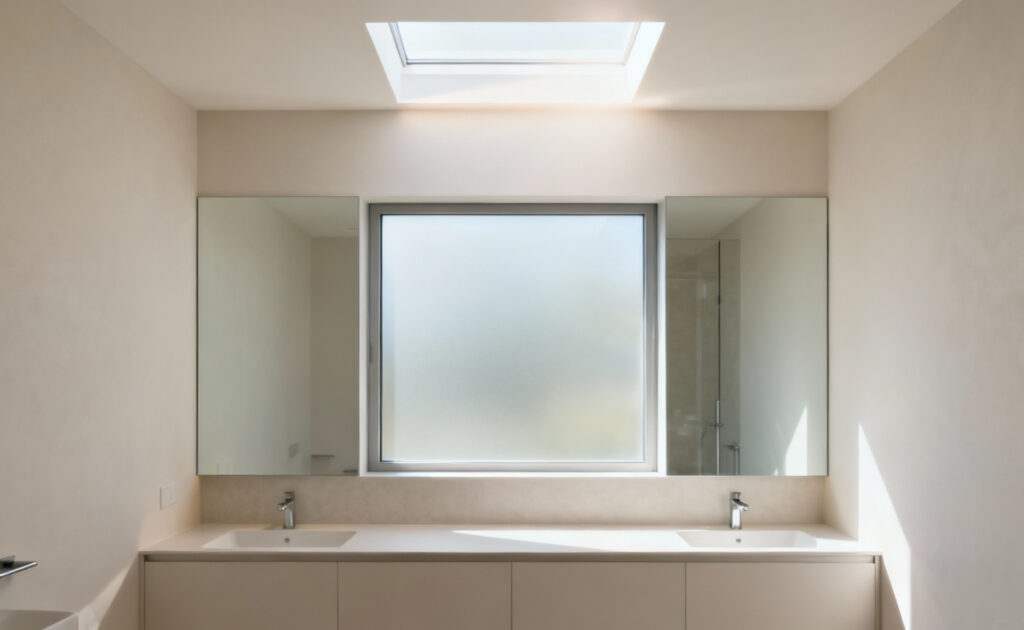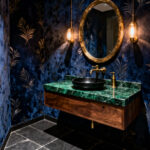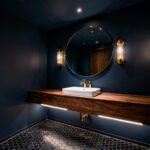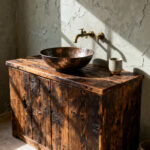Designing a bathroom is, I believe, an act of profound self-authorship. Every choice reflects not just an aesthetic preference, but a deeper statement about how you integrate well-being into the fabric of your daily life. The most compelling personal sanctuaries are not merely decorated; they are mindfully curated to be havens of restoration. They tell a story about a commitment to calm, clarity, and renewal. These 20 principles represent a philosophy of design, providing the ultimate bathroom renovation inspiration to separate a truly nurturing space from one that is simply beautiful.
As a wellness design consultant, I’ve dedicated my career to understanding the intricate dance between our environment and our health. The modern bathroom has evolved far beyond its functional roots. It is now a vital retreat, a private space where daily rituals become opportunities for rejuvenation. This isn’t just about selecting luxurious fixtures; it is about engineering an environment that consciously supports your body’s rhythms, soothes your senses, and cultivates a deep sense of peace.
Our exploration will move organically from the foundational to the sublime. We begin with the biophilic imperative—reconnecting with light and life—before weaving wellness into the very materials you select. From there, we will optimize the flow and sensory comfort of the space, and finally, integrate technologies that elevate daily routines into profound acts of self-care. Let’s begin to transform your personal space into the well-being hub you deserve.
Establishing a Foundation of Tranquility: The Biophilic Design Imperative (Part 1)
Our journey begins by answering an innate human call: the need for connection with the natural world. This is the essence of biophilic design. By thoughtfully weaving elements of nature into our most private spaces, we create an environment that doesn’t just look serene—it fundamentally calms our nervous system and grounds our spirit, laying the foundation for every design decision that follows.
1. Prioritizing Natural Light Integration for Circadian Rhythm Harmony
The conversation about a truly restorative bathroom must begin with light. Not just any light, but the living, dynamic light of the sun. It is the most powerful wellness tool we have, a silent conductor orchestrating our body’s natural circadian rhythms, which govern everything from our sleep quality to our mood. To treat light as an afterthought is to miss the single greatest opportunity to imbue a space with vitality.
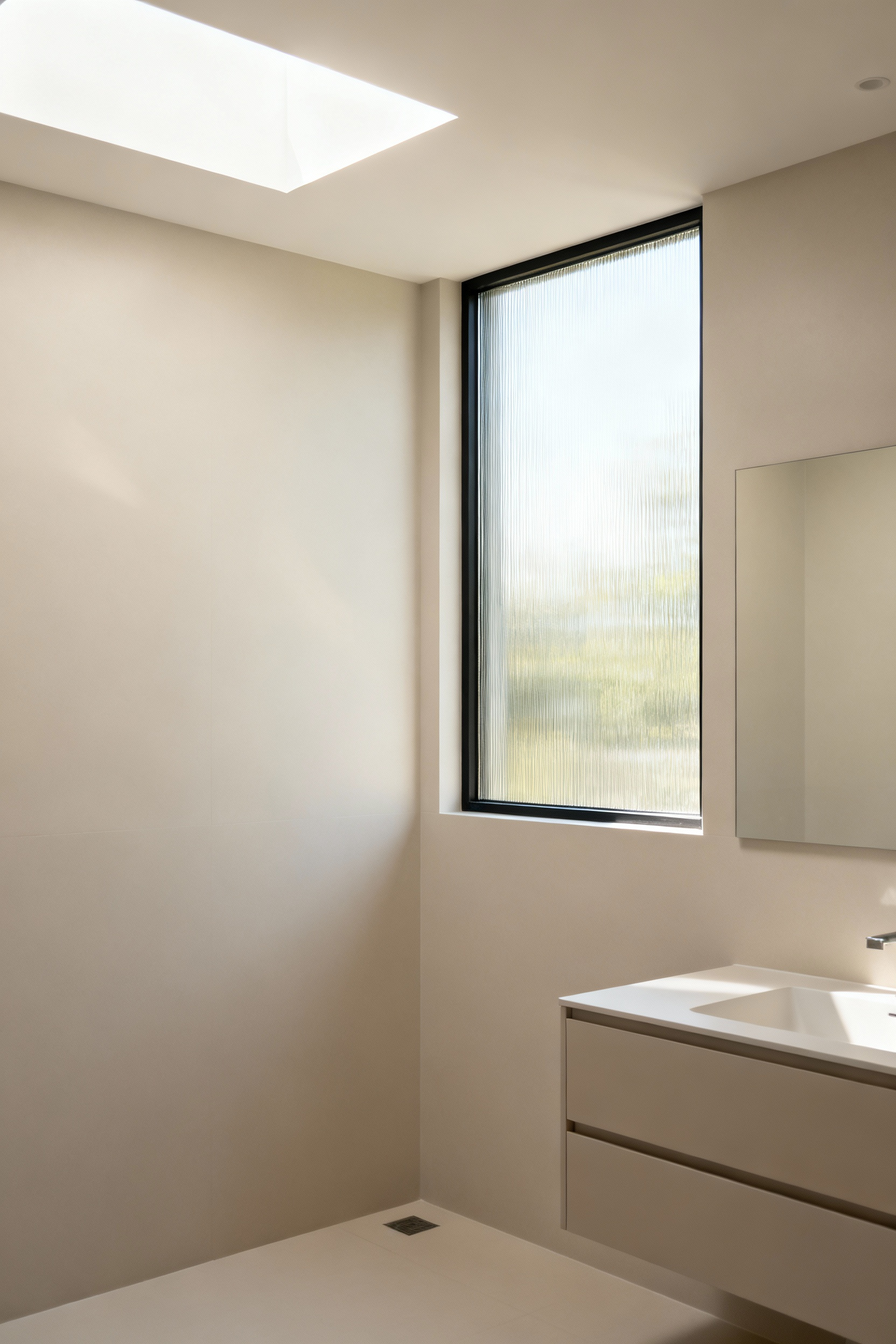
This means we must think differently about materials. In my wellness design practice, I guide clients away from heavy window coverings and toward solutions like translucent blinds, reeded glass, or smart glass that offers privacy without sacrificing precious photons. Surfaces become collaborators in this endeavor; the soft luster of polished nickel fixtures, a large, well-placed mirror, or the gentle sheen of glazed zellige tiles can amplify and scatter daylight, carrying its benefits deep into the room.
The goal is to design a space that feels alive, responsive to the time of day. This may mean strategically locating a skylight over the shower to create a daily ritual of bathing in sunlight or using high clerestory windows to invite light in while maintaining complete seclusion. Integrating daylight this way fosters a more energizing morning and a more peaceful evening wind-down. It’s an approach that supports deeper sleep and lowers stress, transforming your bathroom into a bright, vital retreat that works in harmony with your body’s innate intelligence.
2. Integrating Indoor Biota Through Thoughtful Greenery Selection
With a foundation of natural light established, we can introduce life itself. The presence of plants in our homes speaks to our intrinsic need for connection with nature, a concept known as biophilia. Beyond their beauty, plants are quiet partners in our well-being, naturally purifying the air, balancing humidity, and offering a constant, gentle reminder of the world outside. They are living sculptures that breathe vitality into a space.
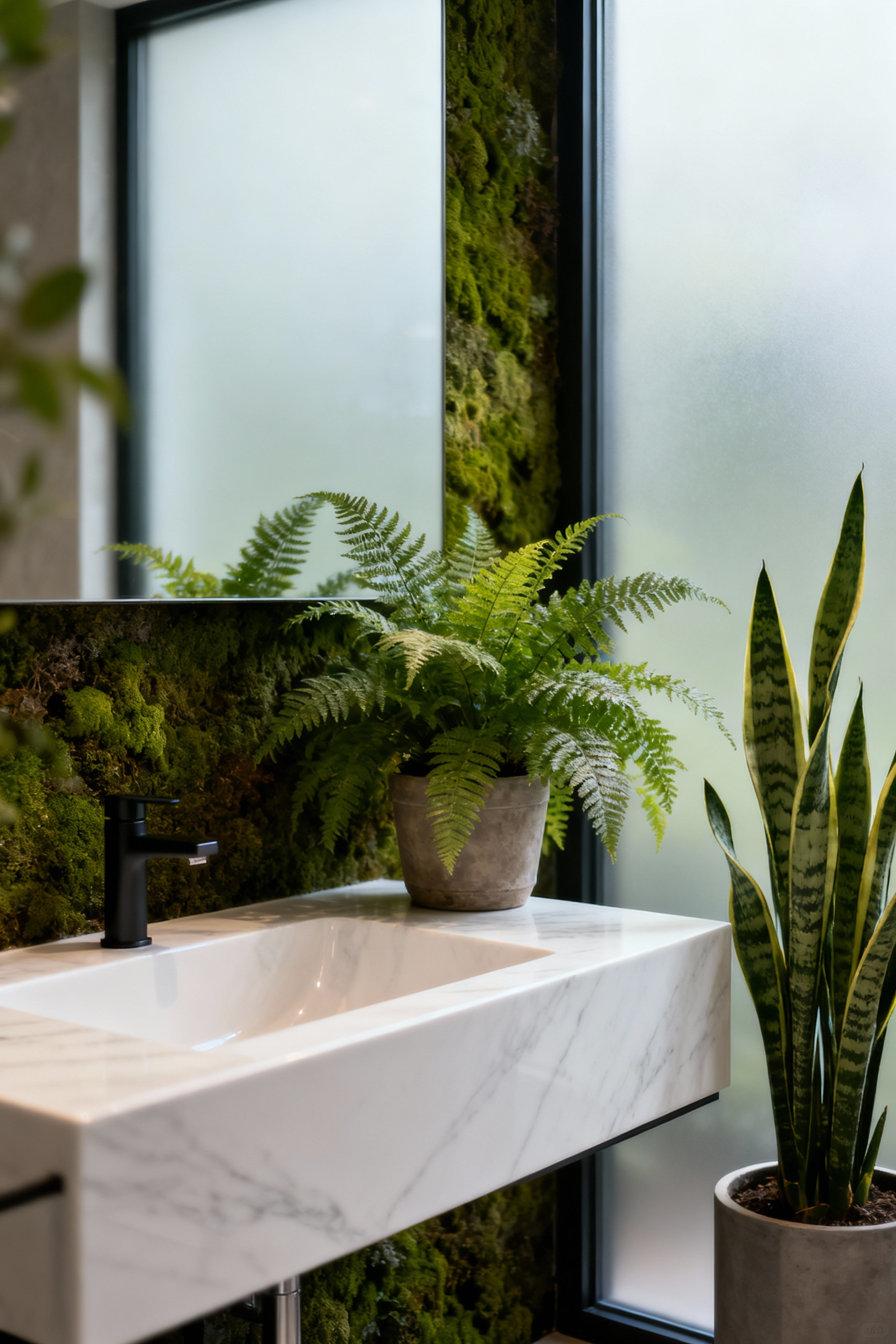
For a bathroom, a unique microclimate of high humidity and variable light, a discerning selection is key. I’ve noticed clients have the most success with resilient species like the Boston Fern, Snake Plant, or elegant orchids, all of which thrive in these conditions. But think beyond just the plant to its vessel—a handcrafted ceramic pot or a simple terracotta vessel introduces an element of earthy, tactile authenticity that complements the living greenery.
For spatial application, consider the breathtaking impact of a living wall, turning a functional surface into a lush tapestry of life. If space is more limited, a few carefully placed plants can have an equally profound effect. A cascade of Pothos from a high shelf or a single sculptural fiddle-leaf fig in a corner can soften architectural lines and introduce organic form. The daily act of noticing their growth or tending to their needs fosters a gentle mindfulness, weaving a deeper connection to nature’s rhythms into your daily routine and making the space feel profoundly nurturing and alive.
3. Embracing Earthy Color Palettes for a Grounding Sensory Experience
The colors that surround us are not passive backdrops; they are active participants in our emotional and physiological state. The philosophy behind an earthy color palette is rooted in the psychology of grounding. Hues drawn from stone, soil, sand, and foliage—from the soft grey of river rocks to the deep green of a forest floor—evoke a sense of stability, safety, and profound calm, which is essential for a restorative environment.
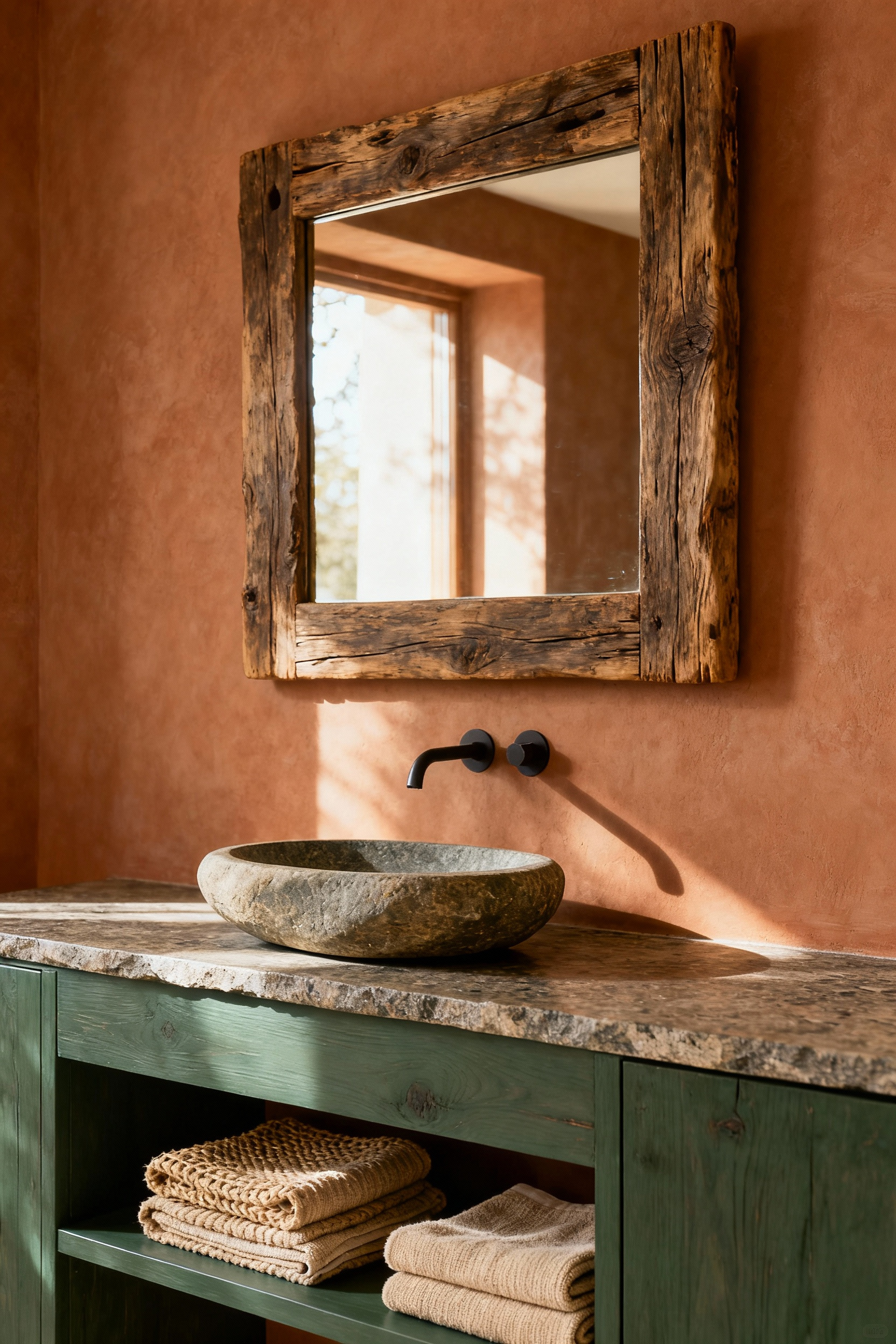
Material selection is where this palette truly comes to life. What I tell my clients is to look for color embedded in the material itself. Think of the warm, variegated tones in a slab of travertine or the subtle, creamy veins of Calacatta gold marble. Natural woods like teak or white oak bring an organic warmth and texture that paint alone cannot replicate. Textiles complete the story: Belgian linen towels in a muted clay tone or a bathmat woven from natural jute adds a layer of sensory depth and reinforces the connection to the earth.
This approach is about creating a harmonious, layered composition. Lighter neutrals, such as sand or soft stone, can form the primary backdrop, creating an expansive, light-filled atmosphere. Deeper accents of moss green, rich terracotta, or charcoal can be introduced through a feature wall of tile or a bespoke vanity to anchor the space. This curated palette creates a protective cocoon, a serene haven from the visual chaos of the outside world. It encourages the mind to quiet down, allowing you to truly unwind and find stillness.
4. Curating Aural Serenity: Soundproofing and Water Feature Dynamics
True serenity is a multi-sensory experience. After curating what we see and touch, we must consider what we hear. Our modern world is filled with noise pollution, a constant source of subconscious stress. The philosophy of aural curation is about intentionally designing a soundscape that fosters deep relaxation, transforming your bathroom into a true sanctuary for the mind.
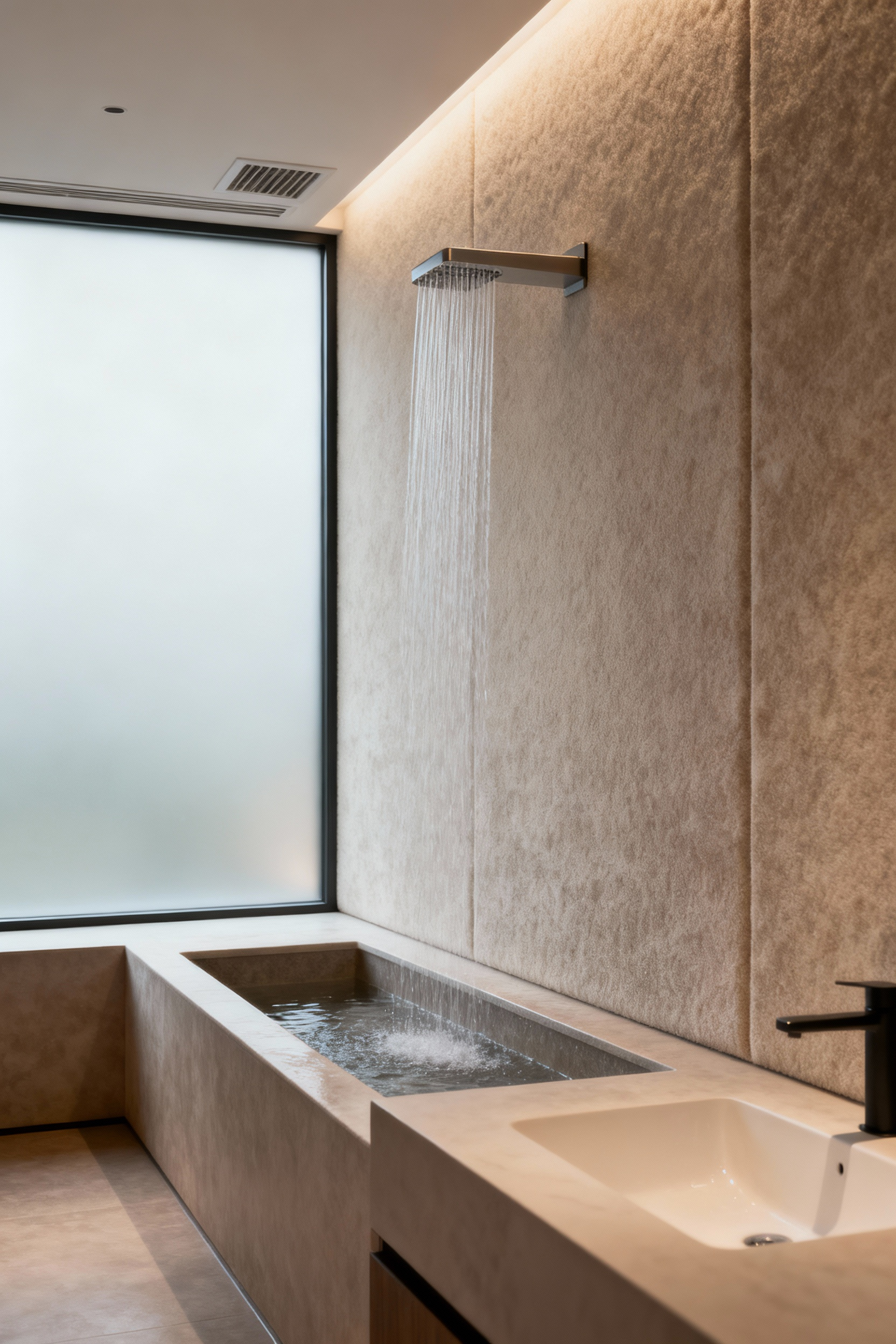
Our material exploration here is two-fold: blocking unwanted noise and introducing harmonious sound. Start by specifying solid-core doors, which are significantly more effective at dampening sound than their hollow counterparts. Within the walls, high-performance insulation can absorb noise from adjacent rooms. It’s a small detail that pays huge dividends in tranquility. Years of mindful space planning taught me that a quiet room is the first step to a quiet mind.
Then, we introduce sound that soothes. This can be as simple as selecting a rain shower head, whose gentle cascade can mask other noises and create a meditative hum. Or, for a more profound effect, consider integrating a small, discreet water feature—perhaps a wall-mounted fountain or a simple stone vessel with a recirculating pump. The gentle, consistent sound of flowing water is primevally calming. Aural serenity allows for deeper meditation during a bath and a more profound sense of escape, ensuring every visit to your bathroom is a restorative act for both body and soul.
Establishing a Foundation of Tranquility: The Biophilic Design Imperative (Part 2)
Building upon our connection to the natural world, we now turn inward. Profound tranquility is also born from visual harmony and a lack of clutter. It’s about creating an environment where the mind is not overstimulated, but instead invited into a state of serene repose. Here, less truly becomes more.
5. Designing for Visual Calmness with Minimalist Aesthetics and Decluttering Strategies
In a world of constant stimulation, visual quiet is a rare and precious commodity. This is the philosophical heart of minimalism in a wellness-focused bathroom: the intentional reduction of visual noise to cultivate mental clarity. When our eyes can rest, our minds can follow. This isn’t about sterile emptiness; it’s about giving each chosen element the space to breathe and be appreciated, creating an environment that encourages quiet contemplation.
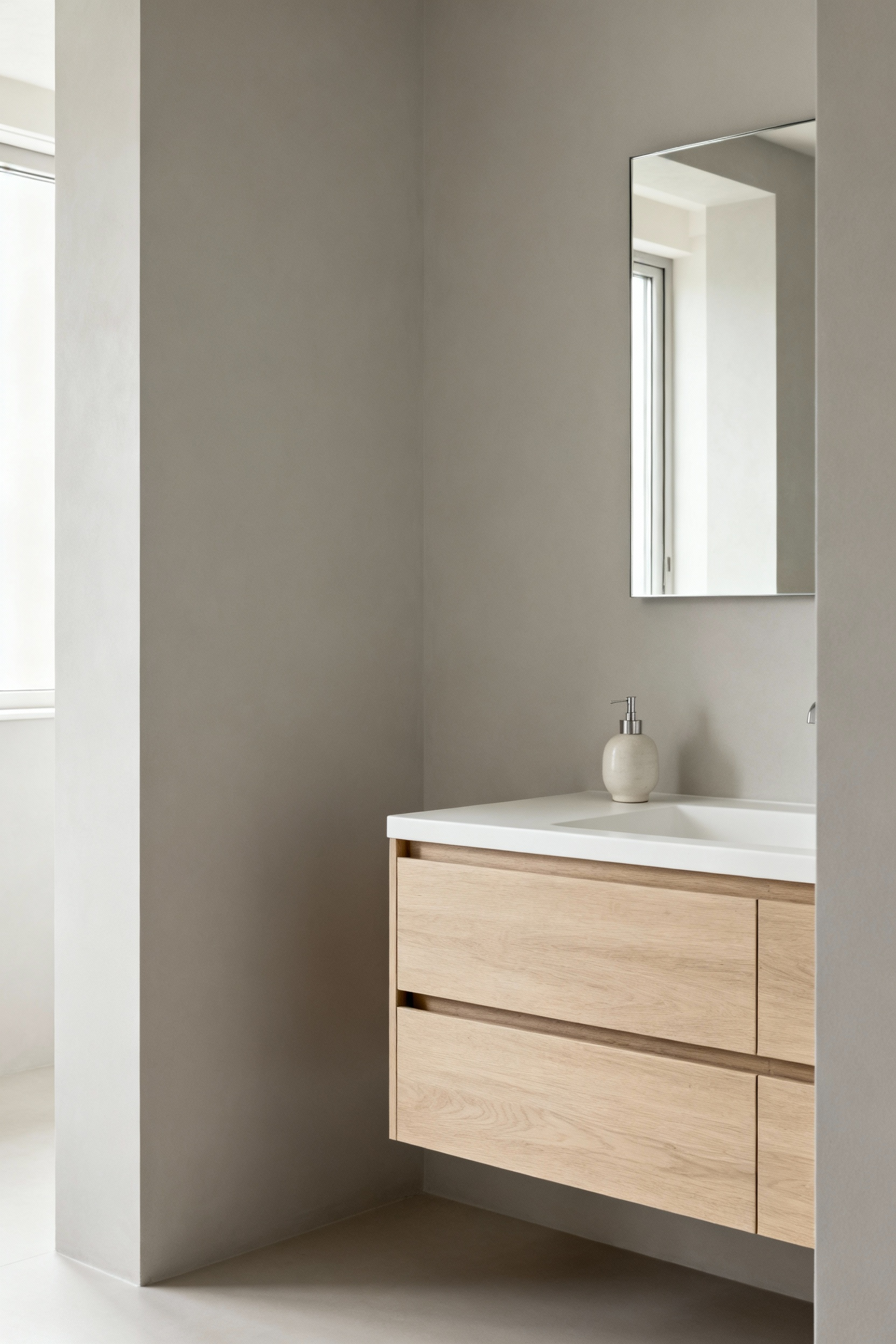
In my work as a Wellness Design Consultant, I often emphasize that this pursuit of calm begins with materials. The focus shifts from ornamentation to authenticity and texture. Large-format tiles with minimal grout lines create a seamless, monolithic effect that is inherently calming. A vanity crafted from a single piece of reclaimed wood, or countertops of honed, matte-finished stone, offers tactile interest without visual distraction. A muted, analogous color palette of soft greys, creams, and natural wood tones unifies the space, preventing visual fragmentation.
Spatially, the goal is clean lines and uninterrupted flow. Wall-mounted vanities and toilets create a sense of spaciousness by freeing up the floor. Storage must be both ample and invisible. This is where integrated solutions are critical: recessed medicine cabinets, custom-built drawers with internal organizers, and full-height pantry-style cabinets that blend into the wall. Every item, from your electric toothbrush to spare towels, should have a designated, concealed home. This dedication to visual order ensures the tranquility you design is not just for a photoshoot but is deeply integrated into your daily life, making sustained peace an effortless ritual.
Conscious Materiality: Weaving Wellness and Sustainability into Surface Selections (Part 1)
The materials you choose are the very skin of your sanctuary. They are what you touch, see, and even breathe every single day. Conscious materiality means looking beyond pure aesthetics to select surfaces that support your health, honor the planet, and possess a timeless authenticity that deepens the soulfulness of your space.
6. Selecting Low-VOC Finishes and Adhesives for Superior Air Quality
The most fundamental element of a healthy home is the quality of the air we breathe. This is especially critical in a bathroom, where humidity can amplify the off-gassing of chemicals from paints, sealants, and adhesives. These chemicals, known as Volatile Organic Compounds (VOCs), can contribute to a host of health issues, subtly undermining the very restorative environment we aim to create. The philosophy here is that true luxury is invisible; it’s the peace of mind that comes from knowing your space is pure.
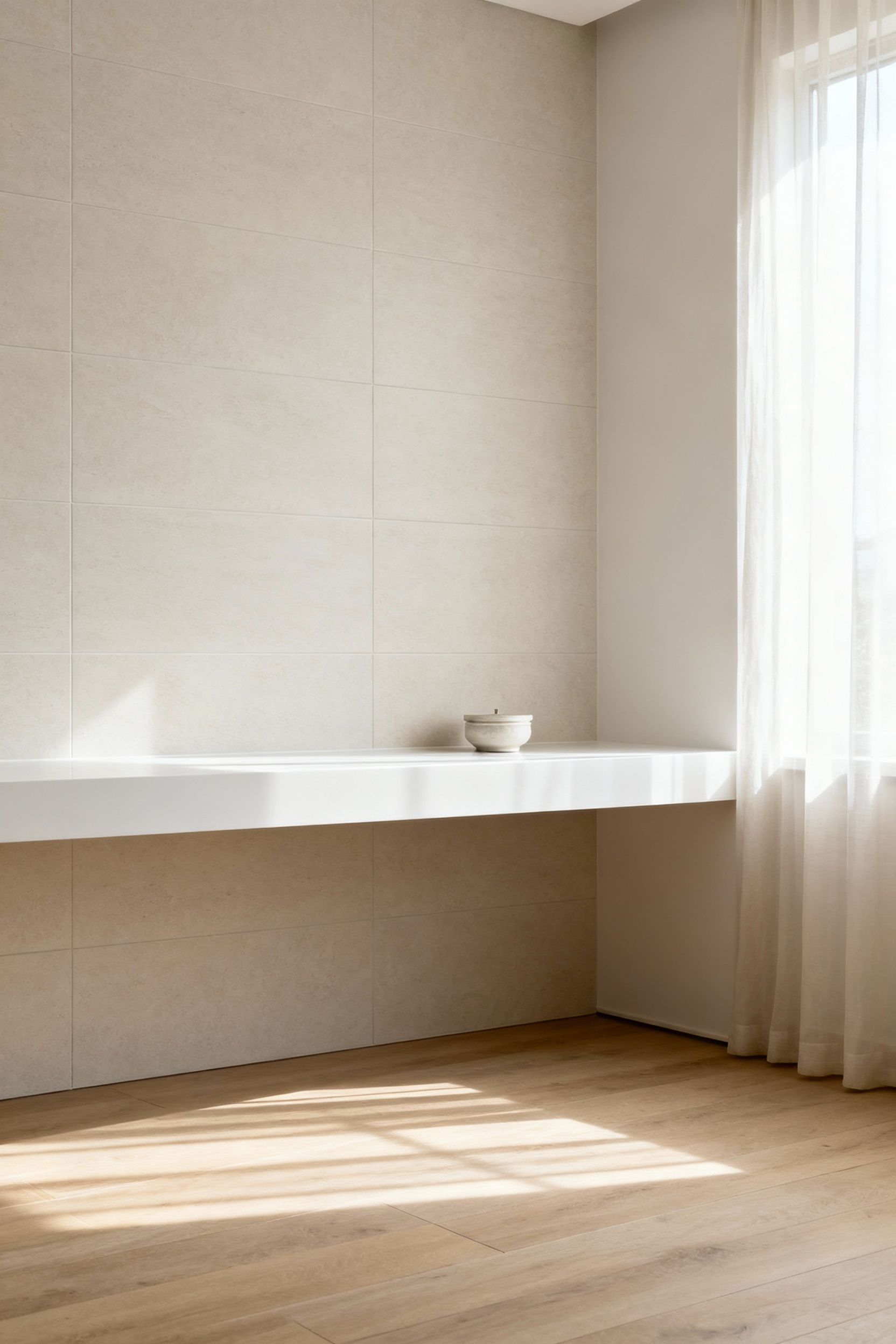
Our material exploration must therefore be rigorous. I learned this early in my career when working with a client who had severe chemical sensitivities; it transformed my understanding of “healthy” materials. Now, I exclusively specify zero-VOC or low-VOC paints, which are readily available and perform beautifully. But it extends beyond paint. Look for Greenguard Gold certified cabinetry, which ensures low chemical emissions, and insist that your contractor use low-VOC adhesives and non-toxic silicone sealants. Every layer matters.
These healthier materials are now designed to withstand the rigors of a humid bathroom, offering excellent durability and mold resistance. By pairing them with proper ventilation, you create a space that doesn’t just look clean but is clean, on a microscopic level. Integrating this into your lifestyle is an act of preventative self-care. It provides a foundation of well-being that allows for truly deep, restorative breaths, ensuring your sanctuary is a source of vitality from the inside out.
7. Opting for Natural Stone and Reclaimed Wood for Tactile Authenticity
Building on the invisible quality of air, we turn to the tangible surfaces that define the sensory character of your bathroom. There is an irreplaceable soulful quality to materials that have been shaped by the earth and time. The philosophy of biophilia tells us that we have an innate desire to connect with nature, and bringing authentic, natural materials into our home is a powerful way to satisfy that craving and feel grounded.
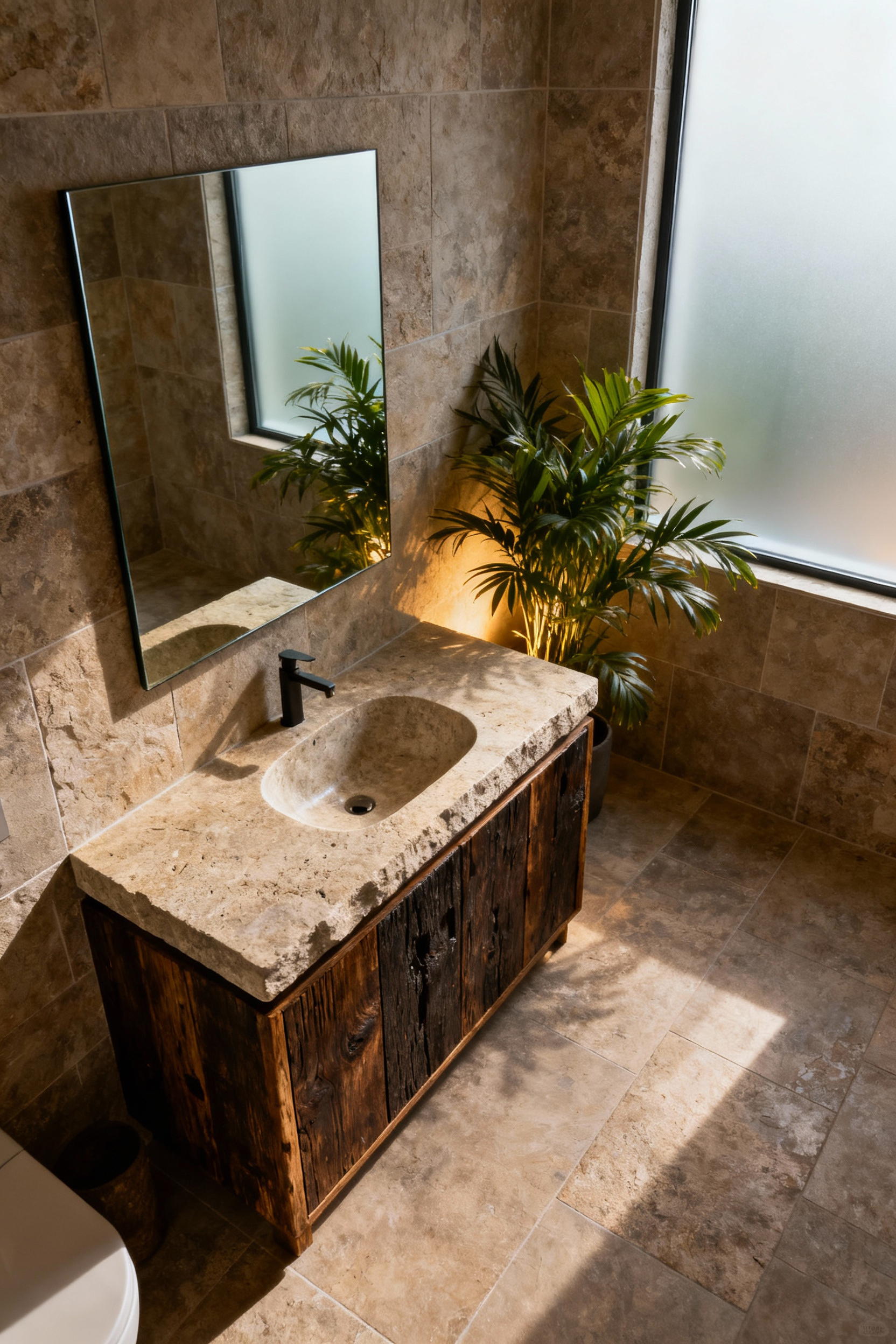
Material exploration here is a sensory journey. Run your hand over the cool, honed surface of a marble countertop; feel the subtle texture of unpolished slate underfoot; appreciate the intricate grain and history in a piece of reclaimed wood. These materials offer a richness and character that manufactured replicas simply cannot capture. They are not perfect, and that is where their beauty lies—in the veins of a stone slab or the nail holes of an old barn beam.
Spatially, these materials can create a powerful dialogue between warmth and coolness. A vanity crafted from warm, reclaimed oak can be beautifully balanced by a countertop and backsplash of cool, grey soapstone. It’s crucial to understand their nature: natural stone requires sealing to protect it from staining, and wood needs a durable, moisture-resistant finish in a bathroom. But this mindful maintenance is part of the relationship with natural materials. This lifestyle integration creates a space that feels timeless and profoundly calming, turning everyday interactions—washing your hands, stepping onto the floor—into moments of tactile connection with the natural world.
8. Evaluating Cradle-to-Cradle Certified Tiles and Countertops for Environmental Stewardship
Our vision of wellness must extend beyond our own four walls to encompass the health of the planet. The most forward-thinking design philosophy today embraces a circular economy, where materials are not just used and discarded but are designed to be safely returned to nature or industry. This is the essence of Cradle-to-Cradle (C2C) certification, a rigorous standard for ecological and social responsibility.
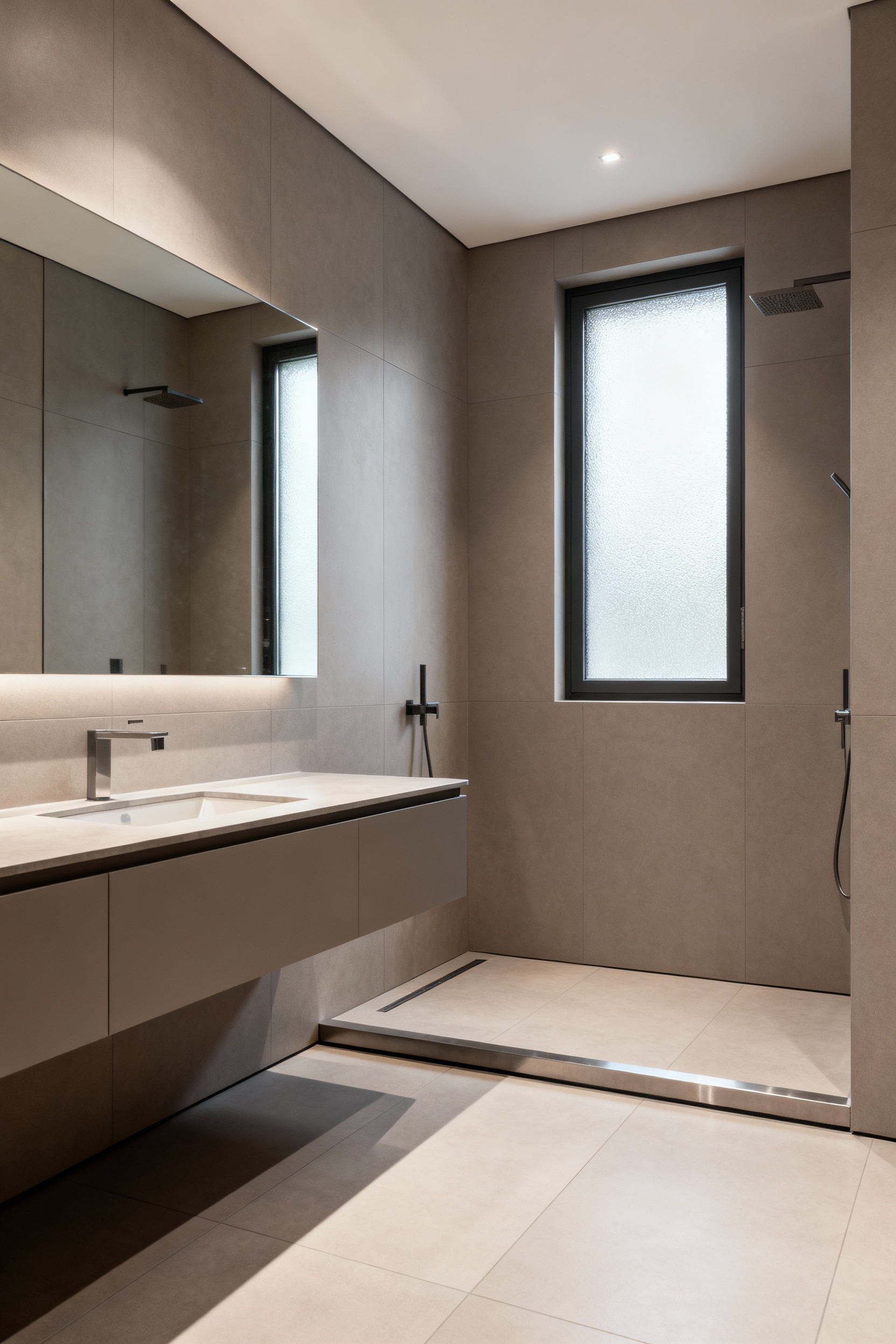
Here’s what’s interesting about exploring C2C materials: it’s an inherently optimistic act. You’re looking at products designed with intelligence and foresight, assessed on everything from material health and reusability to water stewardship and social fairness. This search will lead you to innovative companies making beautiful tiles from recycled content or countertops designed to be fully recycled at the end of their life. You’re choosing materials that contribute to a positive future.
When you select a C2C certified tile for your shower wall or a countertop for your vanity, you infuse your space with a deeper layer of integrity. It’s a visible and tangible expression of your values. Knowing that the foundational elements of your sanctuary were created with respect for both people and the planet elevates the entire experience. It creates a bathroom that isn’t just a place for personal well-being, but a quiet testament to a holistic vision of wellness that includes the world we all share.
Conscious Materiality: Weaving Wellness and Sustainability into Surface Selections (Part 2)
Continuing our deep dive into conscious materiality, we explore surfaces that are not static but dynamic—responding to our needs for light, privacy, and safety. These are choices that actively contribute to the function and feel of your sanctuary, marrying sophisticated technology with foundational principles of well-being.
9. Exploring Smart Glazing for Privacy, Light Management, and Energy Efficiency
The modern sanctuary should be intelligent and responsive. Imagine a space that can shift from open and light-filled to private and cocooning at the touch of a button. This is the transformative potential of smart glazing. This technology, which allows glass to turn from clear to opaque electronically, represents a beautiful fusion of engineering and elegance. It allows us to manage light and privacy with an unprecedented degree of fluid control.
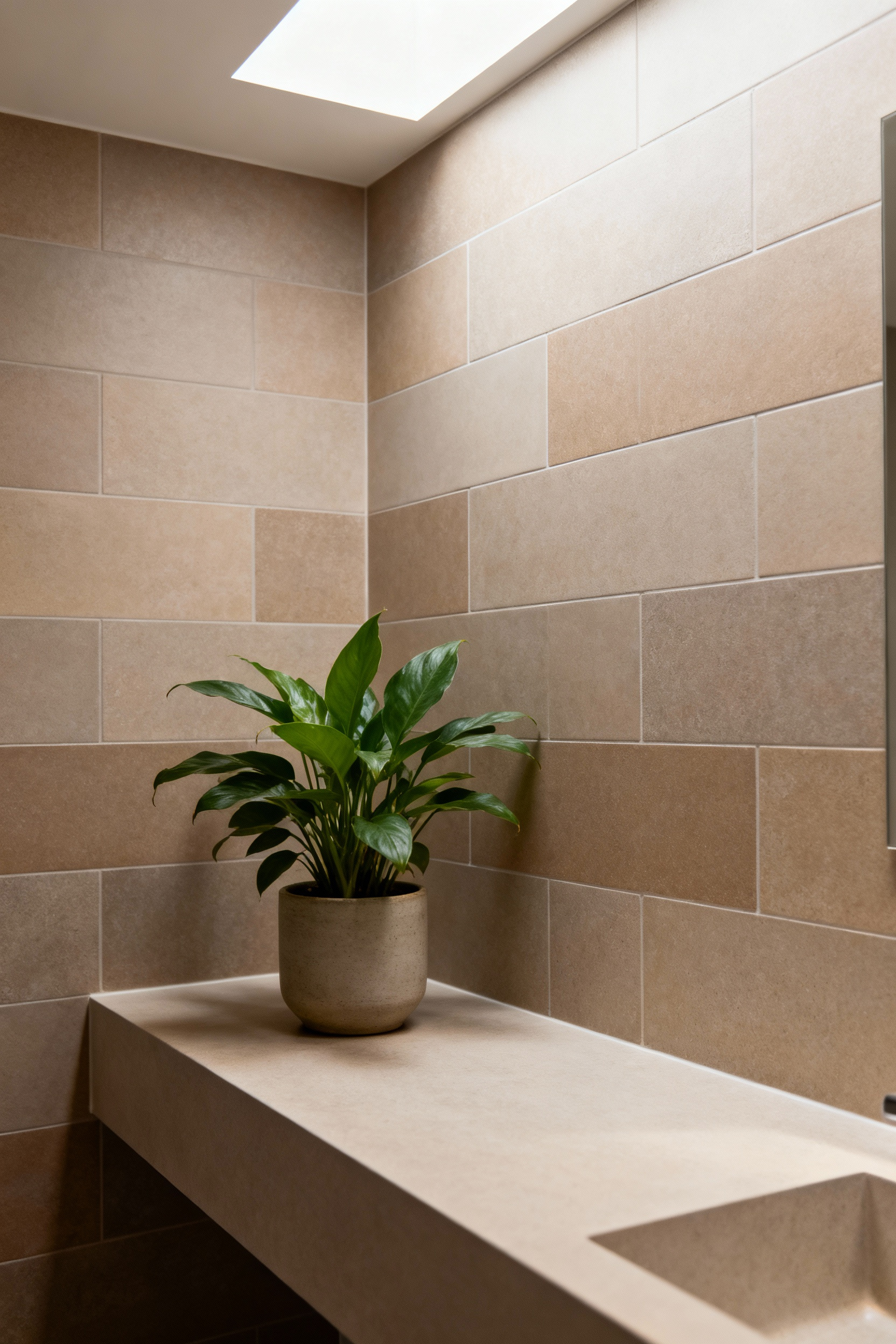
This technology can be applied in wonderfully creative ways in a bathroom renovation. In my urban design projects, where balancing views and privacy is a constant challenge, smart glazing on an exterior window is a game-changer. It eliminates the need for blinds or curtains, maintaining a clean, minimalist aesthetic. It can also be used for shower enclosures, creating a sense of openness in the bathroom that can be instantly made private when in use.
The integration of smart glazing brings profound wellness benefits. By allowing you to control solar gain, it improves energy efficiency. More importantly, it gives you complete mastery over your environment. The ability to effortlessly curate your connection to the outside world enhances your sense of peace and security. It empowers you to tailor the ambiance to your exact needs, whether you’re seeking an invigorating, sun-drenched start to the day or a serene, enclosed space for an evening bath. This is mindful luxury at its most functional.
10. Specifying Non-Slip, Textured Flooring for Enhanced Safety and Sensory Input
A sanctuary must, above all else, feel safe. True relaxation is only possible when our bodies feel secure and grounded. This foundational sense of safety begins from the ground up, with the flooring beneath our feet. From my work in mindful space planning, particularly for clients wishing to age in place gracefully, I know that specifying non-slip flooring is one of the most important wellness decisions you can make.
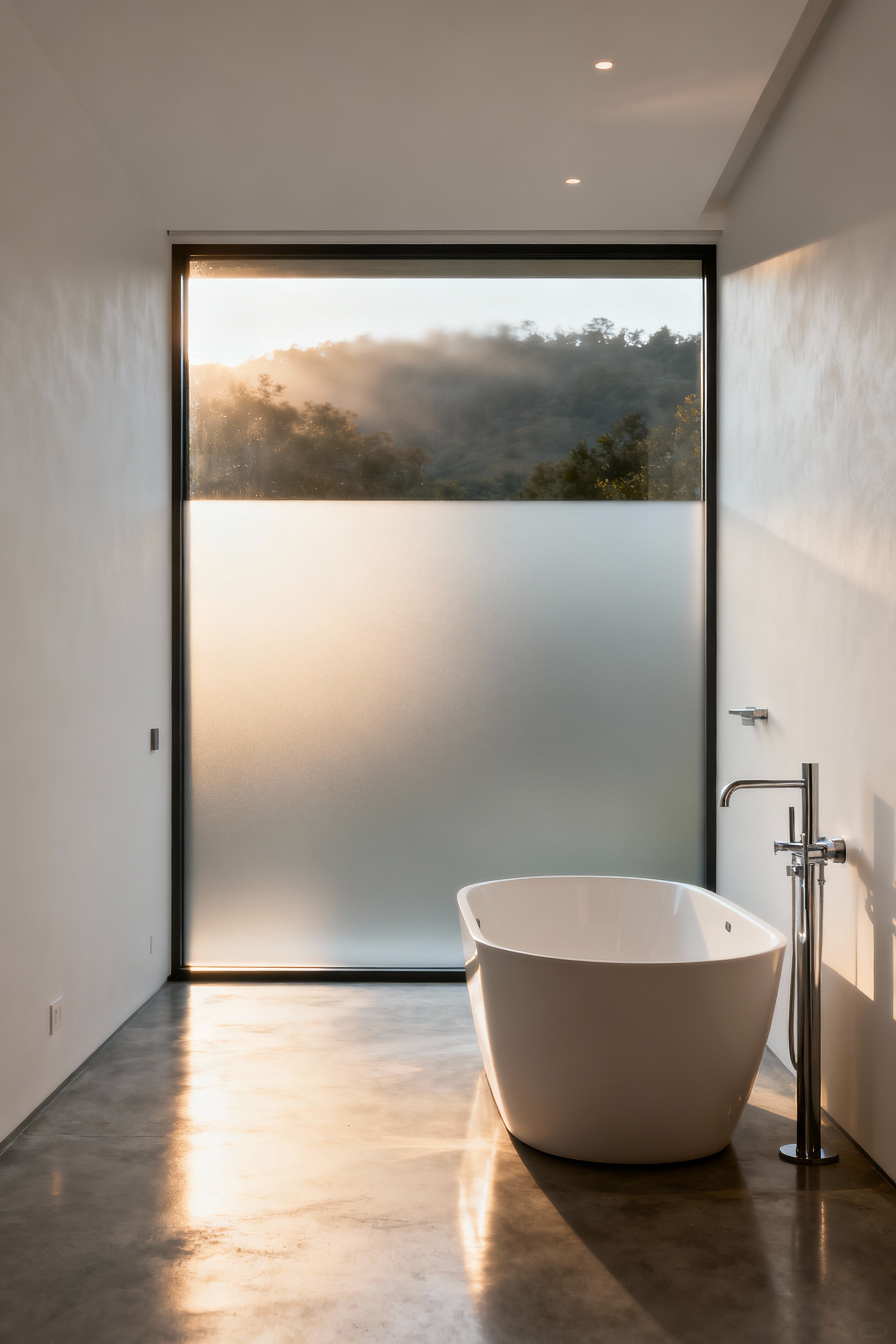
This doesn’t mean you have to sacrifice style for safety. The material options today are sophisticated and beautiful. Consider natural stones like slate or travertine with a honed, matte finish, which offer inherent texture and grip. There are also exquisite porcelain tiles specifically engineered with a subtle, microscopic texture that provides excellent slip resistance, even when wet. For a warmer, more organic feel, cork is naturally anti-slip, anti-microbial, and wonderfully soft underfoot.
Walking barefoot on a subtly textured floor is a grounding, sensory experience. It engages our sense of touch and connects us to our physical space. This choice offers peace of mind for everyone, from families with young children to those planning for their future needs. By thoughtfully integrating safety into your design, you create an environment of unconscious ease. It removes a layer of latent anxiety, allowing for complete physical and mental release—the very essence of a restorative space.
Optimizing the Microcosm: Engineering Intuitive Flow and Sensory Comfort (Part 1)
Now that we’ve laid the foundation with biophilic principles and conscious materials, we focus on the subtle art of space itself. A truly restorative bathroom is one where the flow is intuitive, where every element is placed with purpose, and where the sensory environment is carefully orchestrated to support your well-being. This is where we engineer comfort.
11. Crafting Zoned Lighting Stratagems for Task, Ambient, and Accent Illumination
Light is the most powerful tool an architect has for shaping mood and emotion. In the bathroom, a single, harsh overhead light is a disservice to the space and to you. A sophisticated approach involves layering three distinct types of light, creating a flexible, responsive environment that can adapt to your needs throughout the day. It’s about choreographing light to support every ritual.
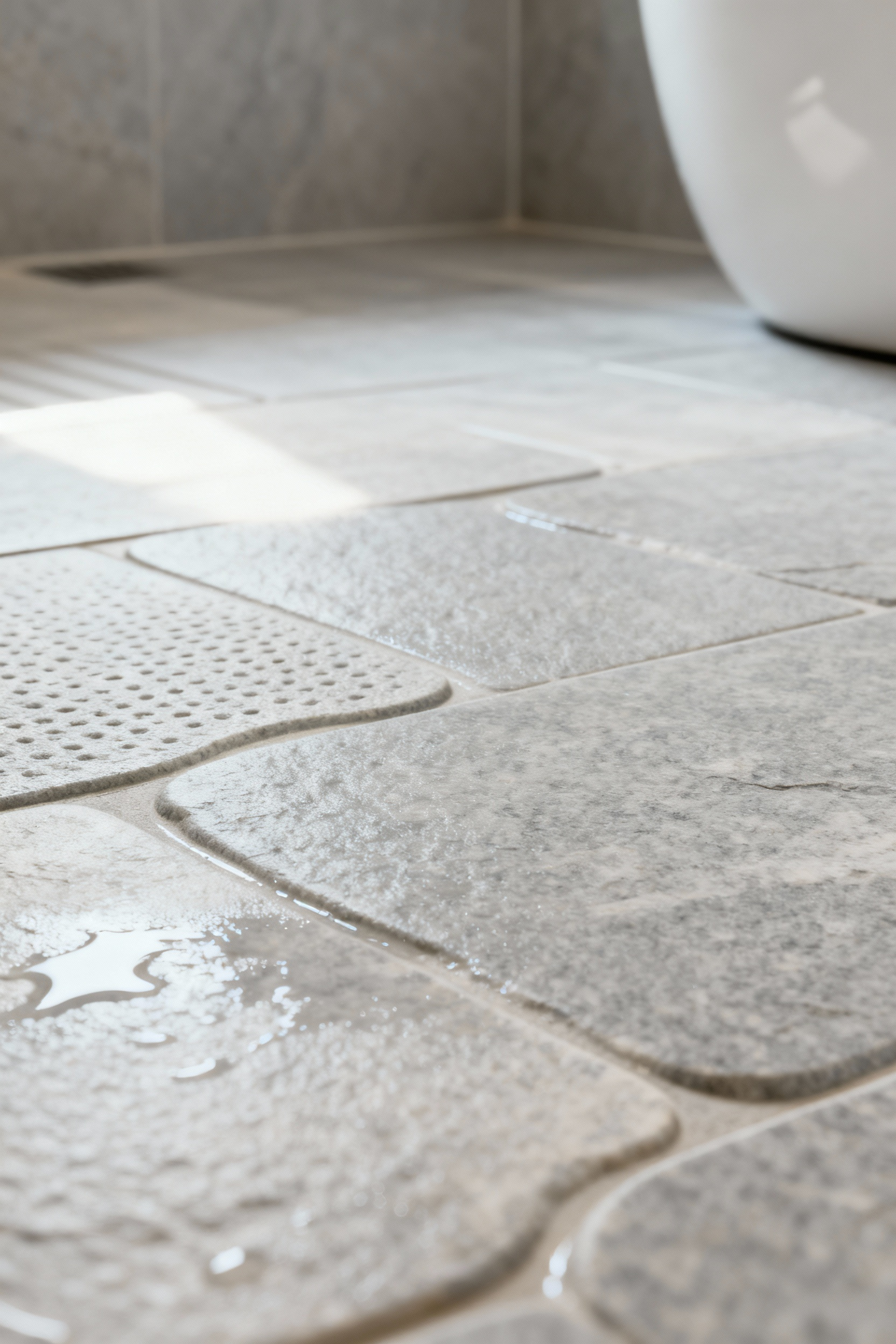
The first layer is Task lighting—bright, clear, and shadow-free for grooming. For the vanity, this means placing vertical sconces on either side of the mirror at eye level. This provides even illumination without casting unflattering shadows. In the shower, a sealed, recessed light ensures safety and visibility. Second is Ambient light, the general, foundational glow that fills the room. This can be achieved with a central decorative fixture or, my preference, with indirect sources like cove lighting or discreet downlights that provide a soft, welcoming illumination.
Finally, Accent lighting adds depth and magic. Think of a wash of light grazing a textured tile wall, or small, integrated lights in a shower niche. I once designed a bathroom where low-level lighting was integrated under the floating vanity, providing a perfect, gentle pathway for nighttime visits without jarring the senses. When these three layers are on separate, dimmable controls, you have complete command. You can create a bright, energizing scene for the morning, and a soft, candle-lit-like glow for a relaxing evening soak. This level of control transforms your bathroom into an adaptable, living space that nurtures you.
12. Implementing Universal Design Principles for Effortless Accessibility and Future-Proofing
Universal design is perhaps the most thoughtful and compassionate design philosophy. It is the practice of creating spaces that are inherently accessible and comfortable for everyone, regardless of age or ability. In my professional experience, I’ve seen how integrating these principles not only “future-proofs” a home but makes it more gracious and comfortable for everyone, every single day.
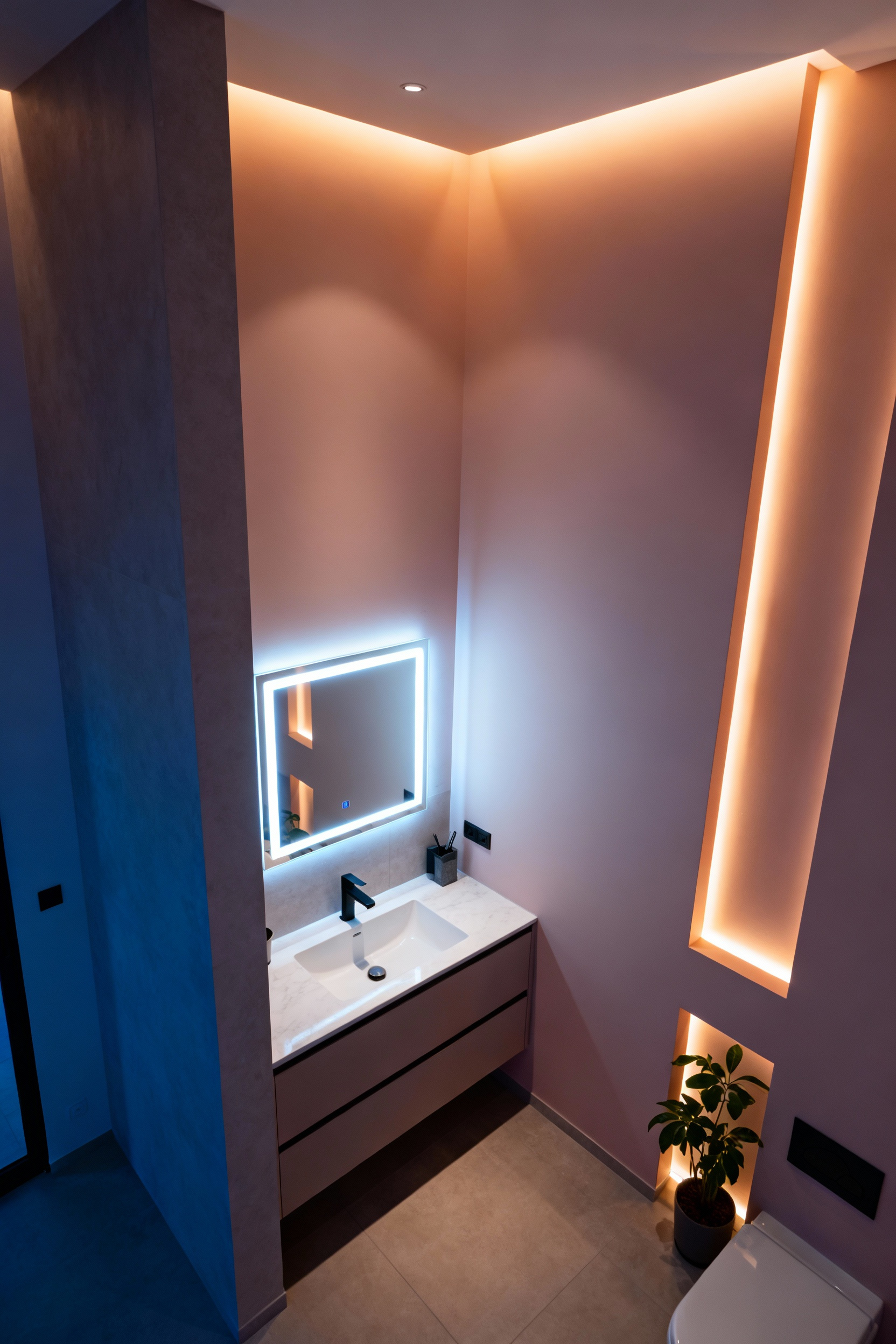
It begins with simple, elegant choices. Lever-style faucet handles are easier for anyone to operate than round knobs. A curbless, walk-in shower not only eliminates a tripping hazard but also creates a seamless, spa-like aesthetic. Specifying a “comfort height” toilet, which is a couple of inches taller than standard models, makes sitting and standing easier for a wide range of people.
In terms of layout, the key is creating ample clearance. A wider doorway and an open floor plan with enough room to maneuver easily feel more luxurious and open for everybody. Grab bars have also evolved; today, they are beautifully designed to coordinate with your fixtures, appearing as sleek, integrated design elements rather than clinical afterthoughts. Embracing universal design is an investment in enduring comfort and independence. It ensures your sanctuary remains a place of ease and restoration for many years to come.
13. Maximizing Vertical Storage Solutions for Seamless Visual Order and Utility
A cluttered space leads to a cluttered mind. Visual order is not just about tidiness; it’s a powerful tool for cultivating inner calm. By engineering storage that is both ample and artfully concealed, we eliminate visual noise and reduce the cognitive load of a messy environment. The most effective way to do this in often-compact bathrooms is to think vertically.
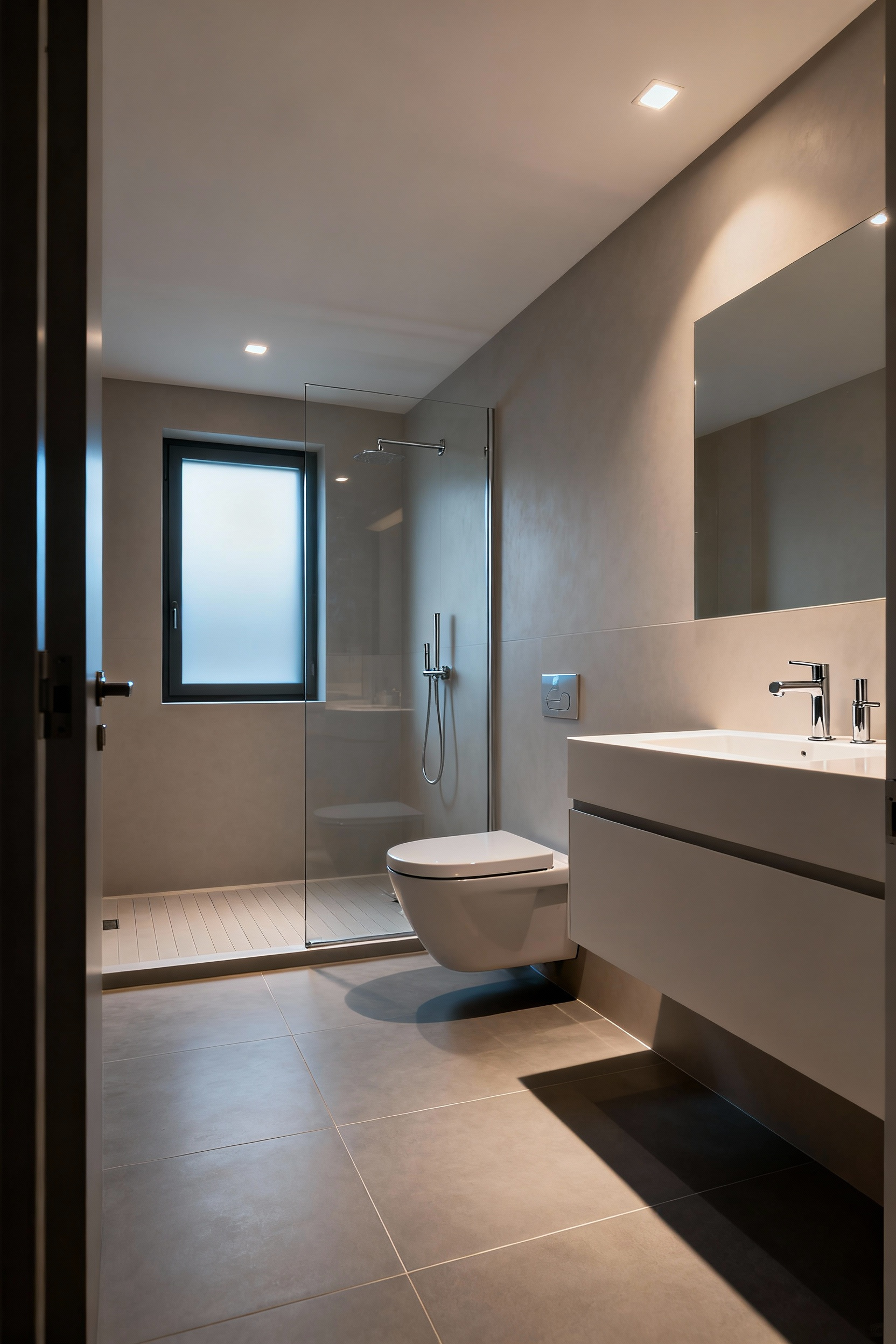
This philosophy translates into seamless, integrated solutions. Recessed medicine cabinets are a classic example, using the space between wall studs to provide storage that is flush with the wall. Full-height, “pantry-style” cabinets can provide an incredible amount of storage for towels, toiletries, and cleaning supplies while visually blending into the wall, especially when finished in the same color. Custom-built joinery is an investment that pays dividends in serenity.
In the shower, I always design a recessed niche for shampoo and soap. It keeps these items off the floor or a clumsy caddy, maintaining clean lines and a sense of order. Under the vanity, deep drawers with custom dividers are far more efficient than cavernous cupboards where items get lost. A well-designed storage strategy makes maintaining order feel intuitive and effortless. It frees your surfaces for what truly matters—perhaps a single beautiful orchid, a piece of art, or an aromatherapy diffuser—allowing your sanctuary to remain a place of uncluttered peace.
14. Specifying Ergonomic Fixture Heights for Enhanced Comfort and Postural Alignment
The best design is felt, not seen. Ergonomics in the bathroom is about the subtle details that support your body’s comfort and alignment during daily routines. When fixtures are at the right height, you remove unconscious physical stressors, allowing for a more fluid and comfortable experience. It’s a fundamental layer of care that quietly improves your well-being every day.
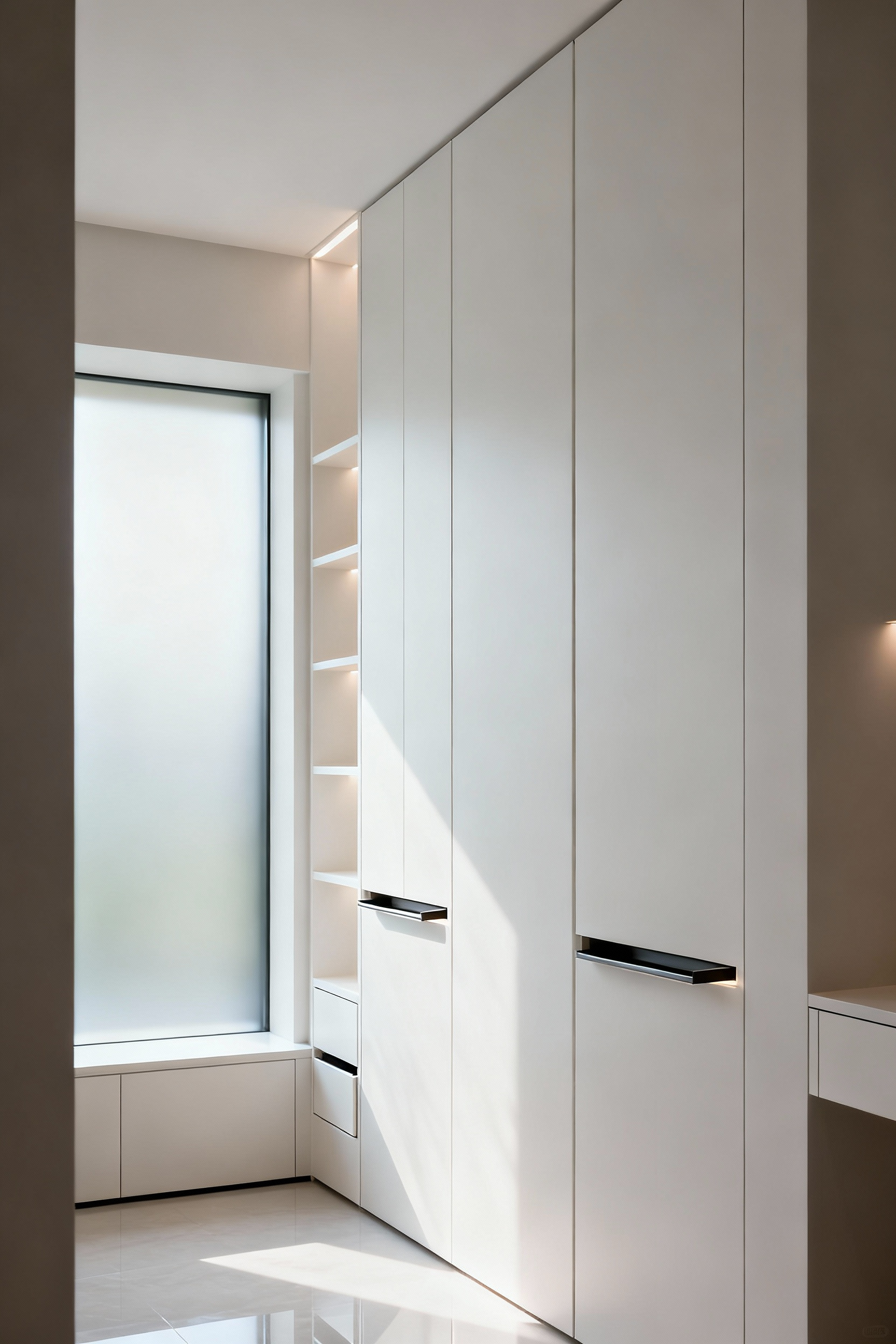
The standard vanity height of 30-32 inches was established decades ago and is often too low for many adults, causing them to hunch over. Specifying a “comfort height” vanity of 34-36 inches can make a world of difference for your back. Similarly, wall-mounted faucets and floating vanities offer incredible flexibility, allowing you to customize heights precisely for your family. I’ve had clients tell me this small adjustment was the most impactful change in their renovation.
In the shower, an adjustable-height hand-held shower wand on a slider bar is a must-have for accommodating people of different heights. For toilets, as mentioned in universal design, a comfort height of 17-19 inches makes a significant difference. This meticulous attention to ergonomics is the embodiment of thoughtful design. It creates a space that feels custom-tailored to you, a place that nurtures a deeper, more harmonious connection between you and your environment.
Optimizing the Microcosm: Engineering Intuitive Flow and Sensory Comfort (Part 2)
We continue our journey into the heart of the restorative bathroom by focusing on elements that provide active therapeutic benefits. This is where design moves beyond passive comfort and becomes a partner in your daily wellness journey, leveraging the elemental power of water to soothe, heal, and rejuvenate.
15. Integrating Hydration Stations and Temperature-Controlled Shower Systems for Therapeutic Impact
We know that water is essential for life, but a mindfully designed bathroom can transform it into a tool for daily therapy. The philosophy here is to create an environment that makes wellness rituals—like proper hydration and hydrotherapy—feel effortless and luxurious. It’s about proactively supporting your health through intelligent, integrated design.
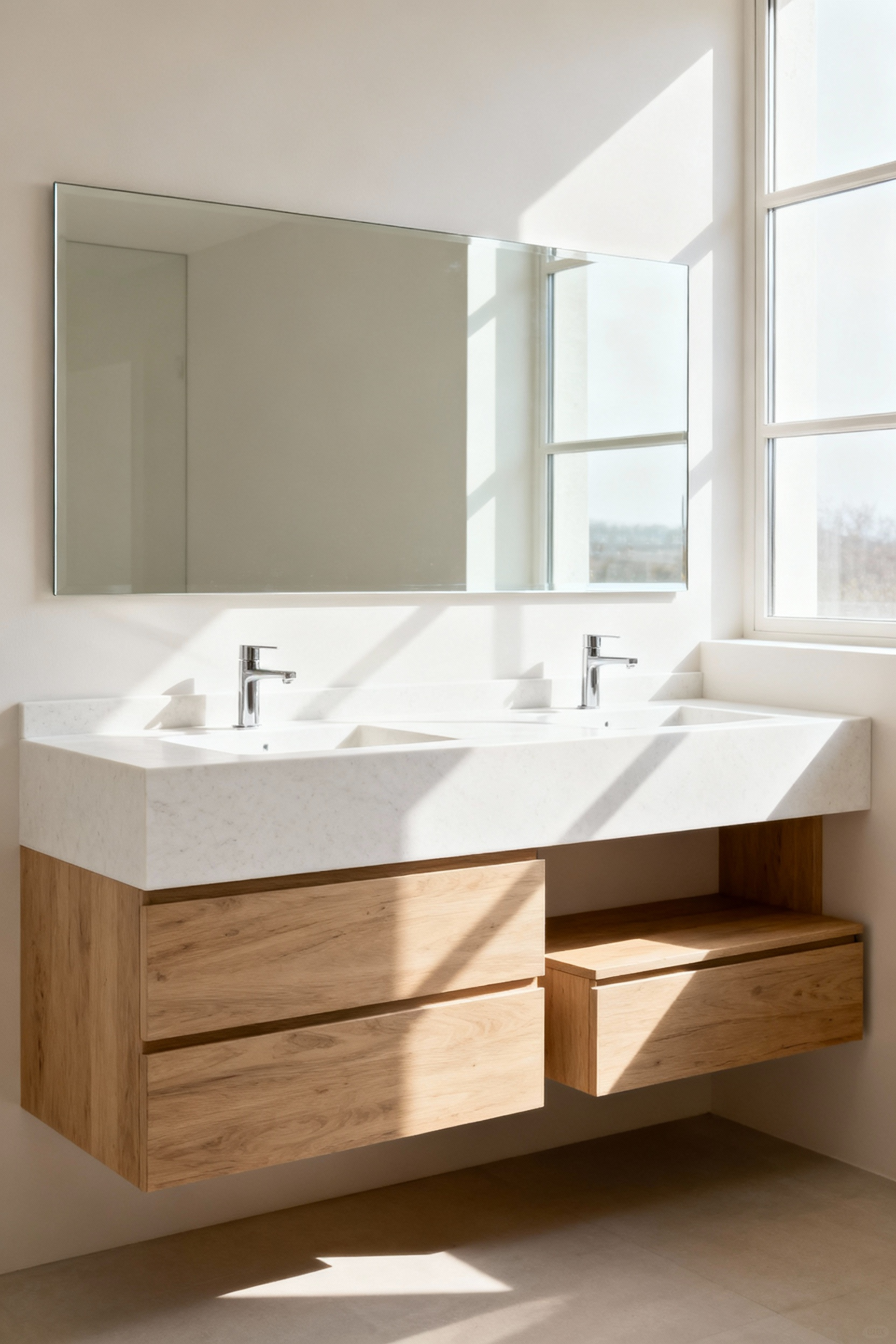
First, consider a hydration station. This could be a small, dedicated niche with a built-in water filter and an elegant carafe, reminding you to drink a glass of water upon waking and before bed. In some of my larger projects, we’ve integrated under-counter chilled and sparkling water dispensers. Second, and most importantly, invest in a high-quality thermostatic shower system. This technology allows you to set a precise, consistent water temperature, eliminating the frustrating and wasteful fiddling with knobs.
A thermostatic system elevates the shower into a true hydrotherapy experience. Digital controls can even allow you to pre-set different profiles—a slightly cooler, invigorating temperature for the morning, and a deeply warm, relaxing temperature for the evening. When paired with a rain shower head for a gentle cascade and body jets to soothe sore muscles, the shower becomes a personalized therapeutic ritual. These integrations turn the bathroom into an active wellness hub, making profound self-care a seamless part of your daily rhythm.
Curating the Ritual: Advanced Comfort and Smart Integration for Holistic Living
Here, we arrive at the final layer of curation, where technology and luxurious details are thoughtfully orchestrated to anticipate your needs and elevate your daily rituals into moments of pure restoration. This is about creating a sanctuary that is not just smart, but wise—intuitively supporting your holistic well-being.
16. Deploying Intelligent Thermostatic Controls for Personalized Climatic Zones
True comfort is about creating a complete sensory envelope. The feeling of stepping out of a warm shower into a cold room is jarring and can instantly undo the relaxation you’ve just cultivated. The solution is to think of your bathroom’s climate not as a single temperature but as personalized zones, orchestrated by intelligent controls. This is the pinnacle of thoughtful bathroom renovation inspiration.
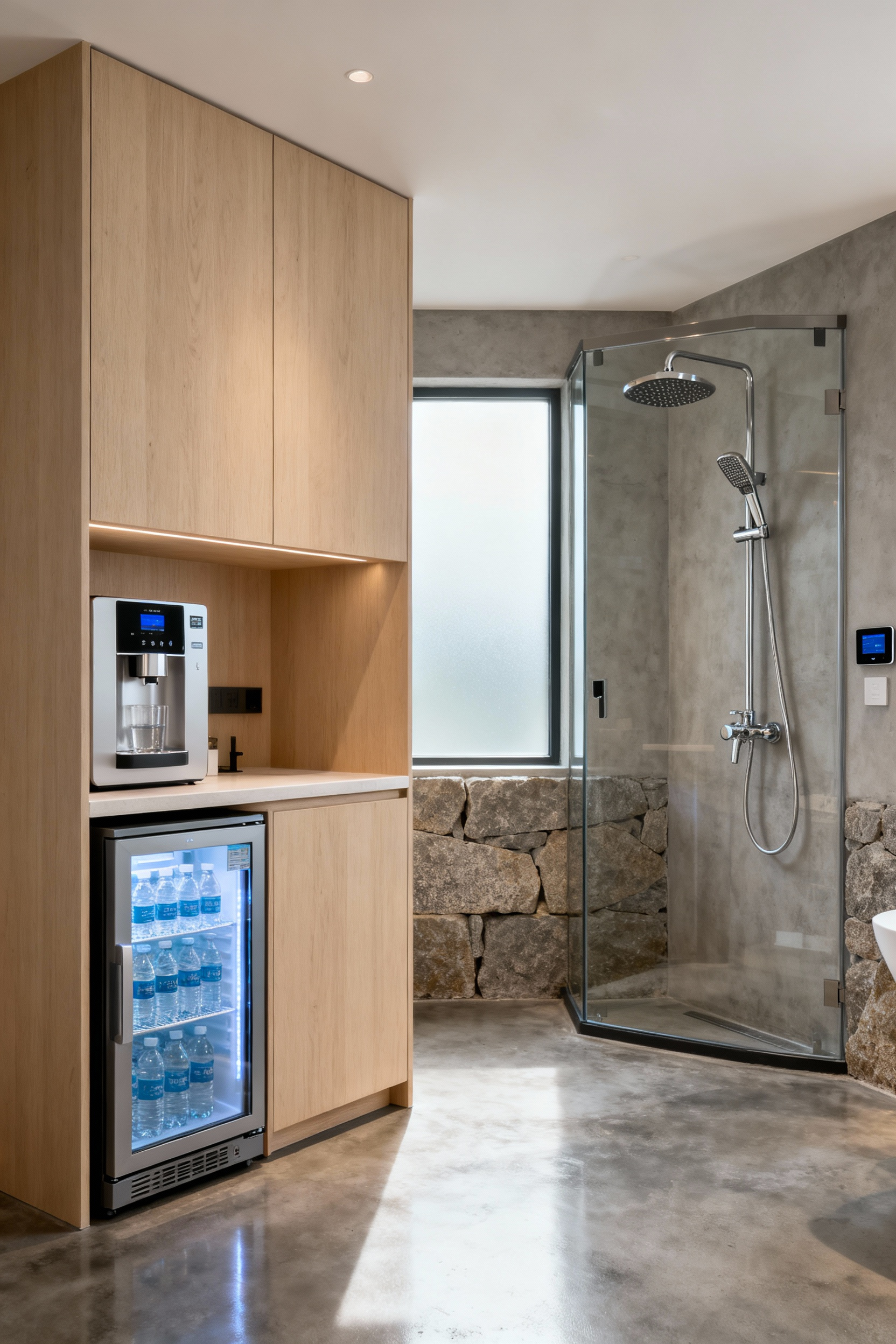
The technology behind this is both sophisticated and seamless. Radiant in-floor heating is the foundation, providing a gentle, luxurious warmth underfoot. This can be zoned so the area right outside the shower is a degree or two warmer. Heated towel racks not only warm your towels but also gently heat the surrounding air. In my wellness design consultant practice, I’m increasingly integrating smart ventilation systems that sense humidity and temperature, quietly maintaining a perfect equilibrium.
Imagine your bathroom pre-warming to your ideal temperature a few minutes before your alarm goes off. Or the heated floor gently activating as you step into the room. This anticipatory comfort transforms the space into a nurturing cocoon. It also promotes energy efficiency by only heating the space precisely when needed. This level of precise environmental control removes a layer of physical stress, fostering a deeper sense of well-being and truly mindful luxury.
17. Implementing Chromotherapy and Aromatherapy Dispersal Systems
Our senses of sight and smell are direct pathways to our emotional centers. Chromotherapy (color therapy) and aromatherapy are ancient wellness practices that use this connection to influence our mood and physiology. Integrating them into your bathroom with modern technology allows you to curate your sensory experience with precision and elegance. What I tell my clients is to think of light and scent as ingredients you can use to create your desired state of mind.
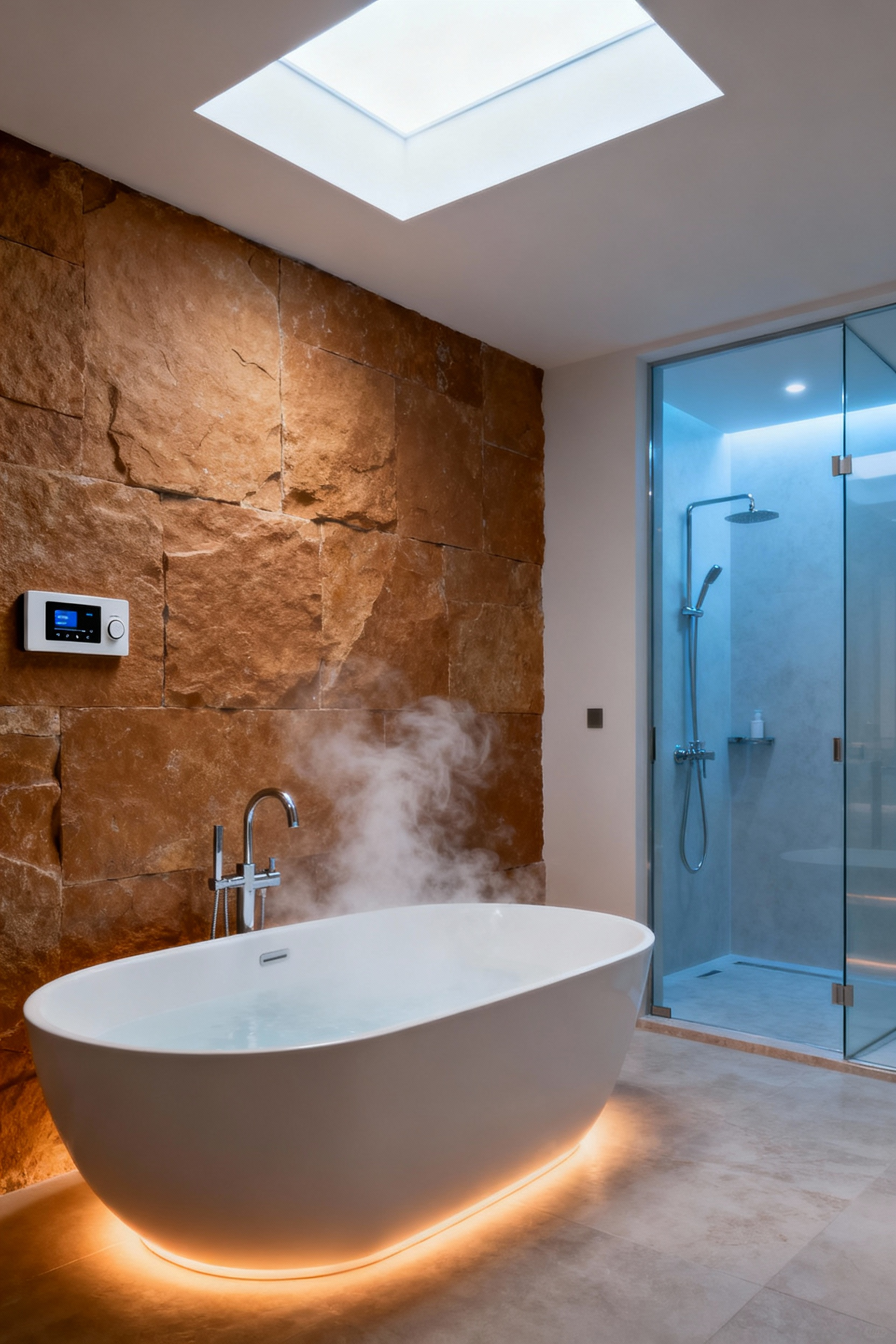
This can be achieved with full-spectrum LED lighting systems integrated into the shower or ceiling coves. These systems allow you to dial in specific colors to suit your intention—a calming blue or violet for a relaxing evening bath, or an energizing yellow or orange for a morning shower. For aromatherapy, integrated diffusion systems that use nebulizing technology are ideal. They atomize pure essential oils into the air without heat, preserving their therapeutic properties and dispersing a subtle, consistent fragrance.
The lifestyle integration is beautiful. You can create pre-set “scenes”: a “Revitalize” scene might pair bright, cool-toned light with the scent of citrus and eucalyptus, while a “Tranquility” scene could combine a soft, warm amber light with the scent of lavender and frankincense. This ability to tune your environment to your inner needs transforms the bathroom into a deeply personalized therapeutic haven.
18. Integrating Discreet Charging Stations and Media Hubs for Digital Detox Zones
In our hyper-connected world, the bathroom can be one of our last true sanctuaries for unplugging. The design philosophy here is about creating a space that supports a “digital detox” by mindfully managing our relationship with technology. This doesn’t mean banishing devices entirely, but rather integrating their essential functions—like charging and audio—in a discreet, unobtrusive way.
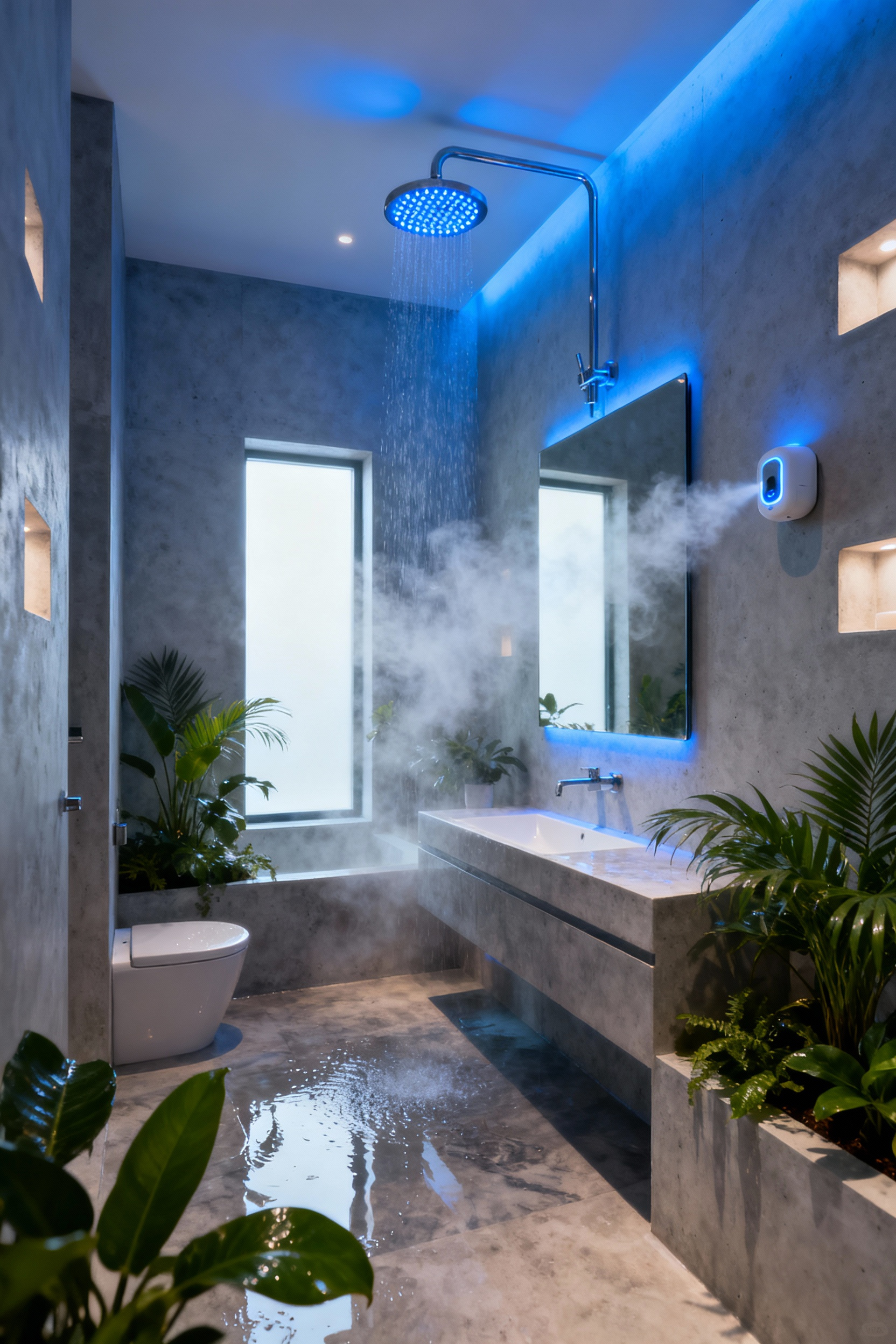
I’ve found the most effective approach is to design concealed charging stations inside a vanity drawer or medicine cabinet. This keeps phones out of sight, reducing the temptation to scroll, while ensuring they are charged and ready when you leave the sanctuary. For music or podcasts, high-quality, waterproof speakers can be flush-mounted into the ceiling or walls and controlled wirelessly, providing beautiful sound without the visual clutter of a portable speaker.
This thoughtful integration allows you to be intentional about your digital consumption. It creates an environment that encourages you to be fully present during your rituals of self-care. You can enjoy the sensory pleasure of a bath or shower without the distraction of notifications and alerts. It’s a design strategy that acknowledges the realities of modern life while fiercely protecting the sanctity of your restorative space.
19. Selecting Plush, Absorbent Textiles and High-Quality Robing for Elevated Tactile Comfort
After we have orchestrated light, sound, scent, and temperature, we return to the most fundamental and intimate sense: touch. The quality of the textiles in your bathroom is the final, crucial detail that completes the experience of mindful luxury. To wrap yourself in a soft, plush, absorbent towel or a beautiful robe is the ultimate gesture of self-care.
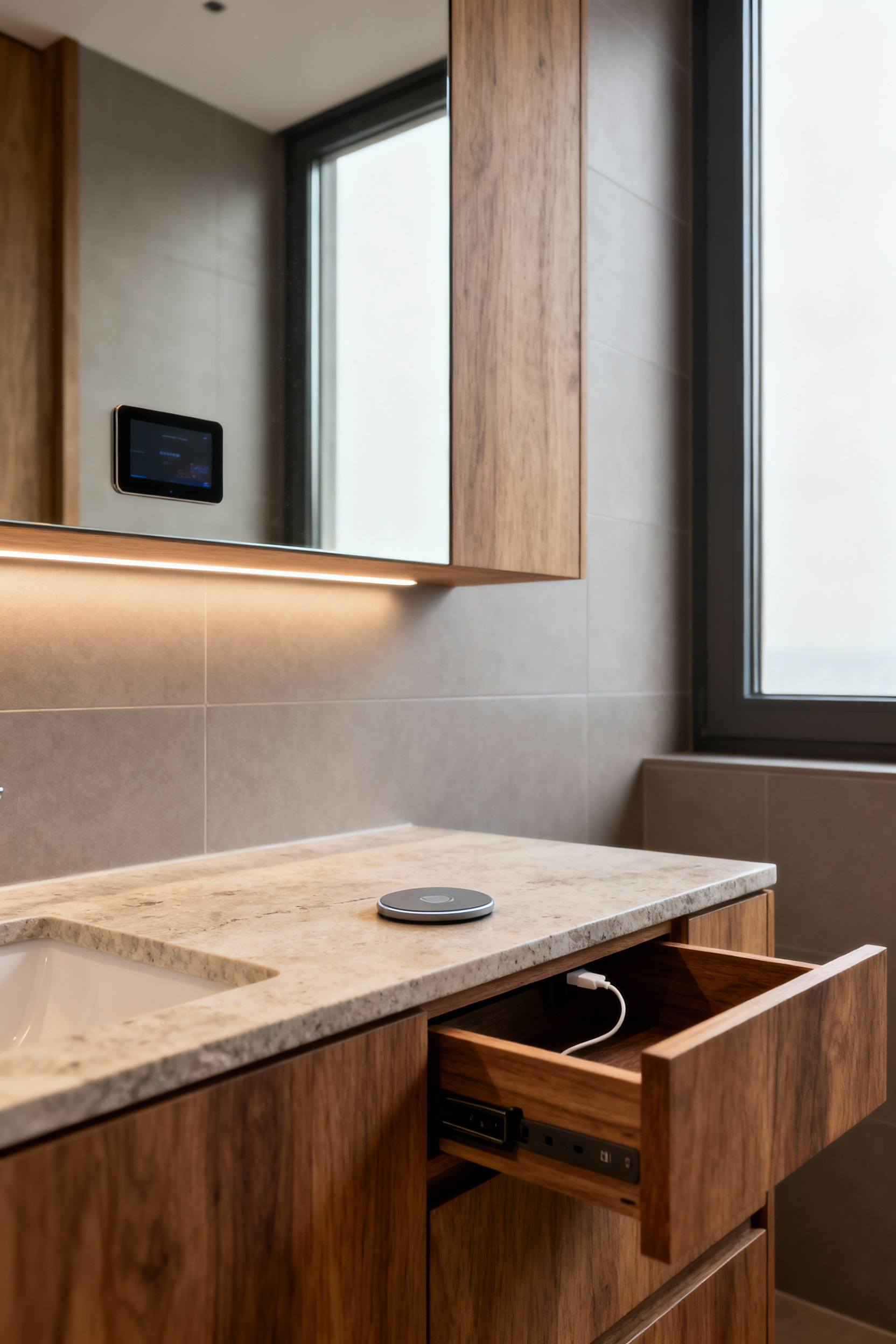
I always end my projects by focusing on these tactile elements. The material exploration here is about quality and fiber. Look for towels made from 100% long-staple Turkish or Egyptian cotton, known for their exceptional softness and absorbency. Pay attention to the GSM (grams per square meter)—a count of 600-900 indicates a dense, plush, spa-quality feel. For a robe, a waffle weave offers a light yet cozy texture, while a velour or microfiber provides sumptuous softness.
These textiles are not just accessories; they are integral to the aesthetic and sensory experience. Stored on a heated towel bar or artfully rolled in an open niche, they add a layer of visual softness to the space. Most importantly, they elevate the simple act of drying off into a moment of pure pleasure and comfort. This final, tactile embrace reinforces the feeling of being cared for and nurtured, cementing your bathroom’s role as a true sanctuary for holistic well-being.
Conclusion
Throughout these twenty principles, we have journeyed far beyond the conventional view of a bathroom, reimagining it as an intimate sanctuary engineered for well-being. From the foundational calm of biophilic design to the tactile comfort of a perfect towel, we’ve seen how every decision can be an intentional act of self-care. A truly restorative space is born not from a single grand gesture, but from the harmonious interplay of countless thoughtful details.
As you embark on your own bathroom renovation inspiration, I encourage you to see this process as more than a construction project. See it as an opportunity to craft an environment that actively supports and nurtures you. The deliberate choice of healthy materials, the masterful layering of light, the intuitive flow of the space—these are the elements that create a haven where daily routines become restorative rituals.
Ultimately, a mindfully designed bathroom becomes a mirror, reflecting a commitment to your own inner equilibrium. It is an exquisite alchemy of form and intention, resulting in a space that offers not just function, but a profound sense of peace. Let this be your sanctuary, a place where you can begin and end each day in a state of graceful balance.
